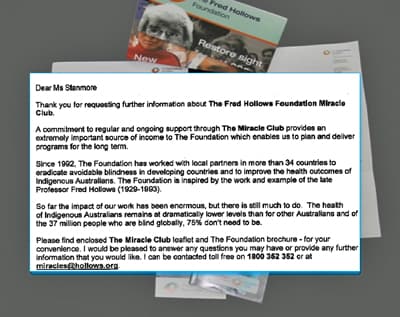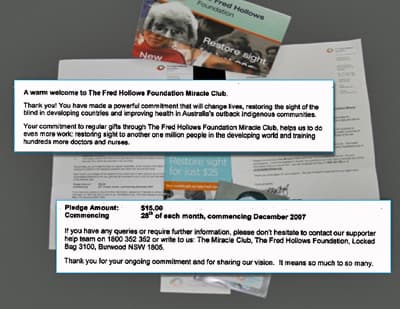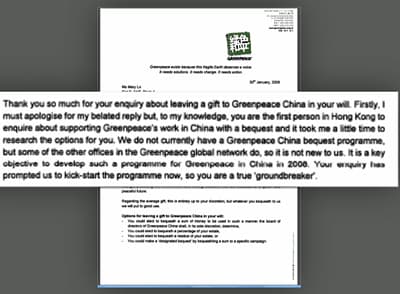Brilliant donor care: 15 steps to make sure your organisation gets it right
Before I launch into some tangible ways to improve the way you deal with donors, let me preface this by looking at the current climate. Just how are charities in different parts of the world interacting with donors on a daily basis?
- Written by
- Jonathon Grapsas
- Added
- January 15, 2013
Charities failing to ‘get the basics right’ when servicing donors
Many organisations, over many years have carried out charity mystery shopping exercises. It is sad then that when Pareto Fundraising carried out yet another – our first – in 2005 we found that few organisations had learnt anything about great donor care. When we did another in late 2007, we expected, or at least hoped, that at some charities would have started to deliver on some of the basic principles of donor care that have been pointed out to them so often. Unfortunately this hope turned out to be forlorn. For in some areas things were about to get worse.
The mystery shopping project explained
The project ‘mystery shopped’ 72 charities from Australia, New Zealand and Hong Kong over a period of four months from September 2007. We approached each charity with three key service scenarios: an attempt to set up a monthly gift, an enquiry about leaving a bequest and a complaint.
Within those scenarios we were particularly interested in five key criteria, namely:
- Response times – how long did it take for the charity to respond to the request?
- Thanking levels – whether or not the sender was thanked for his or her offer of support.
- Keeping promises – whether the charity delivered on the promises made during the initial contact.
- Knowledge and passion – how inspiring and knowledgeable were the communications and the people delivering them?
- Donor and beneficiary focused communications – we wanted the contact to be about the individual and
Headline results
What we found was, at times, shocking. Charities across all three countries failed to ‘get the basics right’. Some of the more noteworthy findings were
- Thanking levels were low across the board, our mystery shoppers only being thanked for their offer to give support in 44 per cent of cases in Australia, down from 60 per cent in 2005. In NZ the figure was more encouraging at 87 per cent, in Hong Kong not so impressive at 52 per cent.
- Promoting regular monthly giving to potential donors as the preferred method of support was also less in Australia, from 50 per cent two years ago to a shocking 38 per cent in 2007. In HK and NZ the figures were even worse at 37 per cent in both cases.
- Our success in setting up monthly gifts was again particularly low, a result of charities not following through on their promises. We attempted to set up 208 monthly donations of Aus$10 per month and achieved this 149 times across all three countries, a success rate of 72 per cent.
- We measured the time taken to respond in all three scenarios. Shockingly, 14 per cent of charities failed to respond at all to enquiries about leaving a bequest. Bear in mind that charities had up to two months to do so.
- On the complaints scenario, there were some stark differences in how this was handled across the three countries. In Australia the donor was thanked for her ongoing support in only 19 per cent of occasions (the complaint was made by the mystery shopper who had previously set up a monthly gift); yet it was deemed that the complaint was ‘resolved’ to the satisfaction of the donor in 77 per cent of occasions. In HK the results were 57 per cent for thanking but only 29 per cent deemed ‘resolved’; with NZ 83 per cent on both measures, clearly the leaders in this area
Some pacesetters
Amongst all this doom and gloom, there were some moments of inspiration, like the brilliant and inspiring copy from the Fred Hollows Foundation in Australia (see illustrations, Figs 1 to 3) in response to our monthly gift set-up which read: ‘Thank you! You have made a powerful commitment that will change lives, restoring the sight of the blind in developing countries and improving health in Australia’s outback indigenous communities’. Brilliant stuff.
And the Greenpeace China response to our bequest letter (see illustration, Fig 4). This is fantastic for very different reasons, as you will see. It’s brutally honest and transparent, incredibly personalised and most importantly it shows they care enough to go to the effort of setting up a bequest programme to accommodate our request. Simply outstanding.
Unfortunately examples like these were the exception rather than the norm.
So what can be done to improve the picture overall?
Here are 15 practical and easily implemented steps that your organisation can take to improve your donor care levels, today.
- Set service level agreements (SLAs) for handling response so that you can measure your organisation’s efficiency. Set measures for things such as turnaround times, levels and types of data capture. Be sure however to promote these SLAs and reward those individuals who achieve them.
- Ensure all frontline (donor contact) staff understand the importance of different types of giving, particularly the impact monthly giving (as opposed to one-off gifts) and residuary bequests (as opposed to pecuniary bequests) will have on your work. Remember, great fundraising is actually great donor care, donors don’t know what they don’t know. Tell them the most effective way to support, and why.
- Don’t confuse donors with mixed messages in your communications. Actively promote one method of support and ensure absolute clarity in what you are asking people to do. Sending information on, say, four ways to support in one mailing will only create confusion and, more than likely, will lead to no response from that individual.
- Thank, thank and thank again. An easy mantra to remember and implement. Appropriate and genuine thanking is at the core of brilliant donor care. But remember, thank for the offer/action of doing something, as distinguished to being thanked for the contact. There is a difference. Also, use the words ‘thanks’ or ‘thank you’. Thank ‘you’ is about the donor, ‘we appreciate your support’ is about the organisation. A subtle but important difference.
- Respond to donors in the same way they contacted you. If donors pick up the phone, they want to be spoken to, not directed to your website.
- Keep promises. If you promise to send a monthly giving form, make sure you send it. If you promise to set up a monthly gift, ensure it is set up. And so on. The number of times we as a sector fail to listen and follow through on our assurances is astonishing.
- Make donors and your beneficiaries the focus of communications, not your organisation. Donors aren’t motivated by the history and status of your charity, they want to feel important and know their support will have a direct impact on your beneficiaries.
- Personalise communications wherever possible. Even handwritten sticky notes and compliment slips show you have taken the time to make that person feel like the individual they are.
- Focus on value and not cost – see your supporter services or donor care function as a value centre, not a cost centre. The best example I have seen of this is Greenpeace in Australia. They changed the job titles of their supporter services teams to, wait for it…. ‘Fundraisers’! A small but brilliantly effective tactic that immediately changed the dynamic of that function. The mindset then shifts from being process driven and reactive to being accountable and proactively looking at ways to leverage more support from donors.
- Invest in the people at the frontline: in adequate training, in adequate resources and in ensuring they are up to date at all times (with relevant case studies to share, up-to-date information about current appeals, etc). They are literally the ‘Director of First Impressions’ of your organisation so make sure they are given the tools to deliver on that impressive title.
- Produce and deliver inspiring, not functional, communications. Endeavor to make sure each individual feels even more empowered at the end of that conversation than she did beforehand, regardless of the nature of the contact and the outcome. Critique all of your written materials and ask yourself, am I driven to support this cause as a result of this piece? It may be a brilliant cause, but be honest and ask yourself if it is a brilliantly executed and empowering piece?
- Listen to what donors are saying and confirm their personal details at every opportunity – it ensures mistakes are minimised and ultimately more gifts are received. It also demonstrates you care enough to get the fundamentals right.
- Make it as easy as possible for donors to respond to any communication. Remove any barriers. Such barriers include response forms in a small font, no reply paid envelope included, incorrect donor details on the response form. They are a turn off and ultimately suppress response.
- Honesty truly is the best policy. If you are having significant delays in processing and turning around thank you letters, tell donors. Under promising and over delivering really is better than the alternative.
- From time to time, mystery shop yourselves and other organisations. You’ll be amazed at what you find and learn. Whether you set up a systematic programme or do it on an ad hoc basis, just do it. Learn from the best whilst ensuring that everyone within your organisation accepts that mystery shopping is part and parcel of everyday life.
So what does the future hold?
What I hope to see moving forward is that the sector doesn’t get distracted by things that don’t really make a difference to our work. Let’s worry about ‘getting back to basics’. Most charities don’t need to make radical changes and if you work through the 15-point checklist above then I believe you’ll be well on your way to providing an empowering and positive experience for your donors.
If you want any more advice or ideas on delivering brilliant donor care, or simply want to share your experience, good or bad, then please contact me at jonathon.grapsas@paretofundraising.com.
© Pareto Fundraising 2008





















